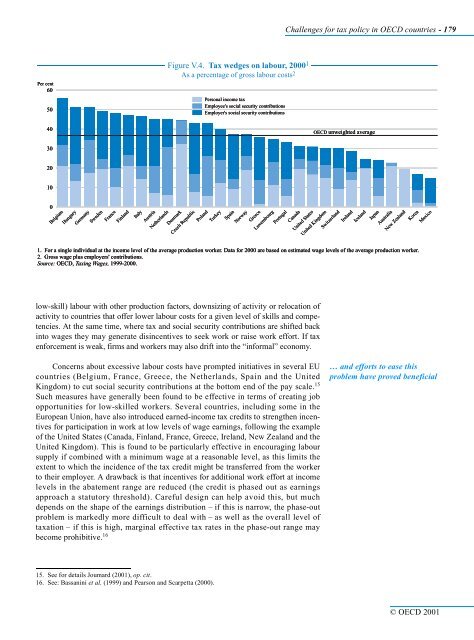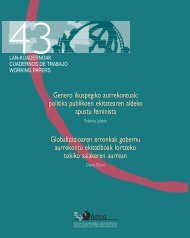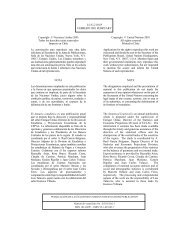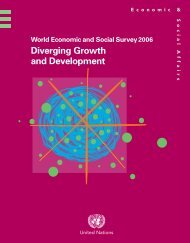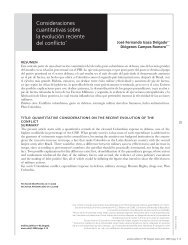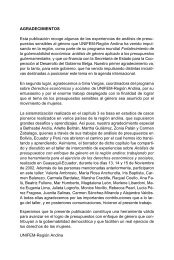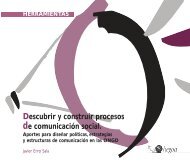OECD Economic Outlook 69 - Biblioteca Hegoa
OECD Economic Outlook 69 - Biblioteca Hegoa
OECD Economic Outlook 69 - Biblioteca Hegoa
Create successful ePaper yourself
Turn your PDF publications into a flip-book with our unique Google optimized e-Paper software.
Per cent<br />
60<br />
50<br />
40<br />
30<br />
20<br />
10<br />
0<br />
Figure V.4. Tax wedges on labour, 20001 As a percentage of gross labour costs2 Figure V.4. Tax wedges on labour, 20001 As a percentage of gross labour costs2 Figure V.4. Tax wedges on labour, 20001 As a percentage of gross labour costs2 Personal income tax<br />
Employee's social security contributions<br />
Employer's social security contributions<br />
low-skill) labour with other production factors, downsizing of activity or relocation of<br />
activity to countries that offer lower labour costs for a given level of skills and competencies.<br />
At the same time, where tax and social security contributions are shifted back<br />
into wages they may generate disincentives to seek work or raise work effort. If tax<br />
enforcement is weak, firms and workers may also drift into the “informal” economy.<br />
Concerns about excessive labour costs have prompted initiatives in several EU<br />
countries (Belgium, France, Greece, the Netherlands, Spain and the United<br />
Kingdom) to cut social security contributions at the bottom end of the pay scale. 15<br />
Such measures have generally been found to be effective in terms of creating job<br />
opportunities for low-skilled workers. Several countries, including some in the<br />
European Union, have also introduced earned-income tax credits to strengthen incentives<br />
for participation in work at low levels of wage earnings, following the example<br />
of the United States (Canada, Finland, France, Greece, Ireland, New Zealand and the<br />
United Kingdom). This is found to be particularly effective in encouraging labour<br />
supply if combined with a minimum wage at a reasonable level, as this limits the<br />
extent to which the incidence of the tax credit might be transferred from the worker<br />
to their employer. A drawback is that incentives for additional work effort at income<br />
levels in the abatement range are reduced (the credit is phased out as earnings<br />
approach a statutory threshold). Careful design can help avoid this, but much<br />
depends on the shape of the earnings distribution – if this is narrow, the phase-out<br />
problem is markedly more difficult to deal with – as well as the overall level of<br />
taxation – if this is high, marginal effective tax rates in the phase-out range may<br />
become prohibitive. 16<br />
Challenges for tax policy in <strong>OECD</strong> countries - 179<br />
<strong>OECD</strong> unweighted average<br />
Belgium Belgium Belgium<br />
Hungary Hungary Hungary<br />
Germany Germany Germany<br />
Sweden Sweden Sweden<br />
France France France<br />
Finland Finland Finland<br />
Italy Italy Italy<br />
Austria Austria Austria<br />
Netherlands Netherlands Netherlands<br />
Denmark Denmark Denmark<br />
Czech Czech Czech Republic Republic Republic<br />
Poland Poland Poland<br />
Turkey Turkey Turkey<br />
Spain Spain Spain<br />
Norway Norway Norway<br />
Greece Greece Greece<br />
Luxembourg<br />
Luxembourg<br />
Luxembourg<br />
Portugal Portugal Portugal<br />
Canada Canada Canada<br />
United United United States States States<br />
United United United Kingdom Kingdom Kingdom<br />
Switzerland Switzerland Switzerland<br />
Ireland Ireland Ireland<br />
Iceland Iceland Iceland<br />
Japan Japan Japan<br />
Australia Australia Australia<br />
New New New Zealand Zealand Zealand<br />
Korea Korea Korea<br />
Mexico Mexico Mexico<br />
1. For a single individual at the income level of the average production worker. Data for 2000 are based on estimated wage levels of the average production worker.<br />
2. Gross wage plus employers' contributions.<br />
Source: <strong>OECD</strong>, Taxing Wages, 1999-2000.<br />
15. See for details Joumard (2001), op. cit.<br />
16. See: Bassanini et al. (1999) and Pearson and Scarpetta (2000).<br />
… and efforts to ease this<br />
problem have proved beneficial<br />
© <strong>OECD</strong> 2001


